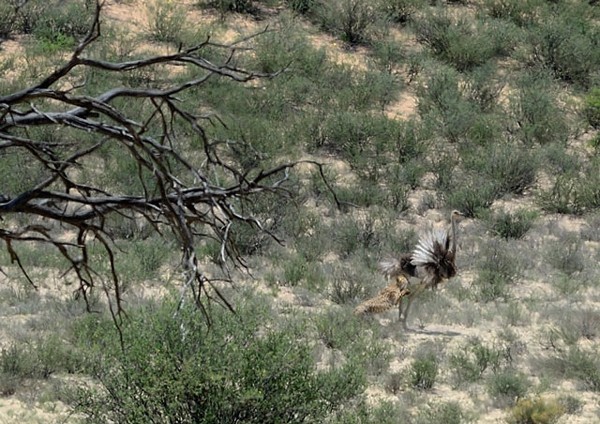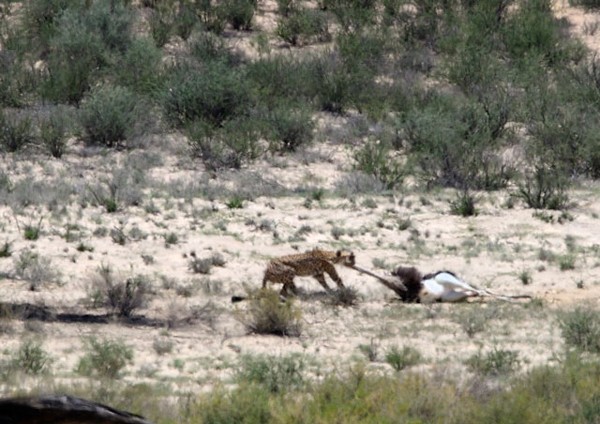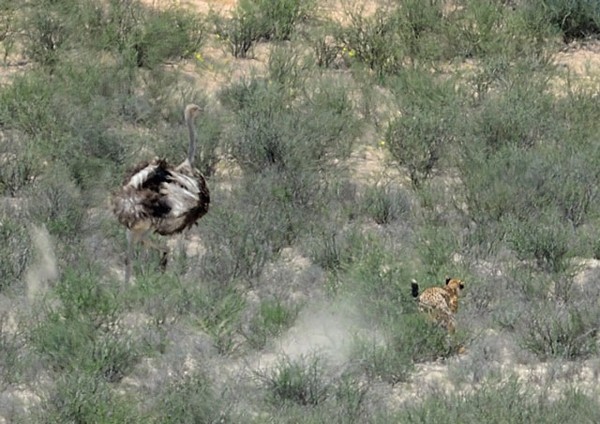Karoline Hanks, a freelance-writer and passionate nature lover, was recently fortunate enough to witness a cheetah successfully hunt an ostrich in the Kgalagadi National Park.
Whilst driving through the Park at around noon, and just after the Nossob road, her and her son spotted a lone cheetah resting under an Acacia tree.
She continues:
“I scanned up and down the river bed with my binoculars (optimistically checking for random, hapless prey material) and spotted three mature ostriches trotting south directly towards her.
I whispered urgently (as one does in a car, in the bush) that there were ostriches approaching, that they were in the line of fire. ‘Lambs to the slaughter’, I said!
My son Tim (avid watcher of ‘Life’, ‘Nature’s Great Events’ and all documentaries with the vaguest whiff of the genius of Attenborough) piped up: ‘She won’t go for them Mom, not on her own. Cheetahs just don’t risk attacking ostriches without backup. Too dangerous. Wa-haaay too dangerous’.The young naturalist had spoken! We took his word for it, and accepted that this particular risk-averse pussy cat would most probably flick her tail and watch them trot by.
But it was not to be. Not today.
She suddenly adopted that classic crouch, with her head and ears flattened and her shoulder blades up.
The tension and electricity in our car was incredible as we realised what was about to play out.
The large male ostrich trotted past and then VOOMP – she leapt. She was incredible. With pin-prick precision and the most phenomenal speed, she bolted towards the middle bird (a female) from the side.
The other two panicked and it was a blur of dust, legs, knees and splayed tail feathers as they fled the scene.
With her supremely athletic body and missile-like focus we watched her veer right, then left, and right again and chase the bird for a good few hundred metres.
Once she gained on the animal, she leapt up, grabbed one of its massive thighs with her paws and the neck with her jaws. After about 15 seconds, with her using her back legs to keep the momentum going, the bird was down. There was an explosion of dust and a 30 second long struggle on the ground with dangerous thrashing legs, a flurry of wings and flaying neck.
And then it was all over.
The dust settled and the bird was revealed – Titanic that she was. I would estimate a healthy 120kg of solid sinew and feathers. This animal had thighs that would make Usain Bolt whimper.
We watched her drag the carcass by the head for about a metre and then drop it and saunter back to the shade of the tree where she flopped down.
It would have been a sizzling 38 °C in the shade at that point. This magnificent cat had just brought down and dragged an animal well over twice her weight and over four times her height.
There was no doubt that she was shattered. We waited for just under an hour – watching to see if she would start feeding, but she didn’t.
A day later we drove to the same spot. The only hint of the previous day’s carnage was a pile of damp feathers and a few bones. We will never know whether our Oscar-winner eventually feasted on her prize or whether other, smaller scavengers of the night enjoyed her winnings.
It was a priceless performance and one we will never forget.”
Source: Africa Geographic Blog







